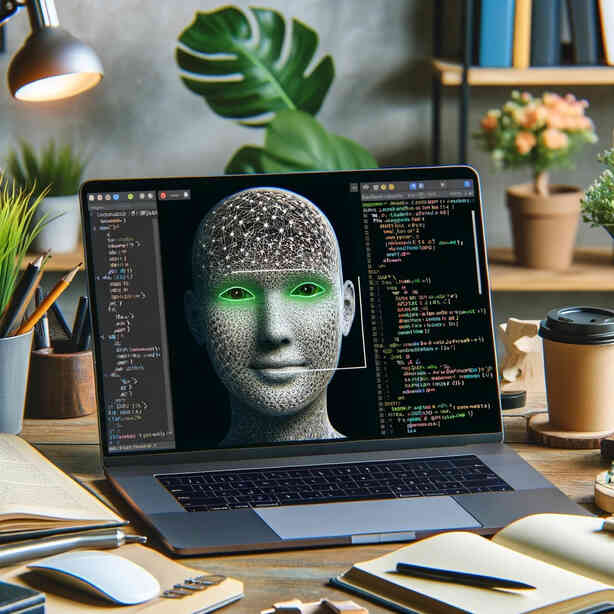Table of Contents
Hey there, tech experts! Whether you're a digital nomad traveling the world, a programmer looking to dive into machine learning, or a data scientist aiming to expand your skill set, this guide is for you. Today, we’re going to explore face recognition using TensorFlow in Python. We'll delve into the face recognition method, the procedural steps, and Convolutional Neural Networks (CNNs) with some hands-on code examples. Let's get started!
Introduction to Face Recognition
Face recognition is a technology capable of identifying or verifying a person from a digital image or a video frame. It compares selected facial features from the image and a facial database. This technology is widely used in security, authentication systems, and social media platforms.
Key Concepts
- Face Detection: Identifying and locating faces in an image.
- Feature Extraction: Extracting unique facial features and creating a numerical representation (embedding).
- Face Recognition: Matching the extracted features against a database of known faces.
Why TensorFlow?
TensorFlow is an open-source library developed by Google Brain. It is widely used for machine learning and deep learning applications due to its flexibility, scalability, and extensive community support. TensorFlow makes it relatively straightforward to implement complex neural networks, such as CNNs, which are highly effective for image-related tasks.
Convolutional Neural Networks (CNNs)
CNNs are a class of deep neural networks, most commonly applied to analyzing visual imagery. They are designed to automatically and adaptively learn spatial hierarchies of features from input images.
Key Components of CNNs
- Convolutional Layers: Apply a convolution operation to the input, passing the result to the next layer.
- Pooling Layers: Perform down-sampling along the spatial dimensions.
- Fully Connected Layers: Neurons are fully connected to all activations in the previous layer.
Face Recognition Procedure
- Data Preparation: Collect and preprocess images.
- Model Building: Design a CNN for face recognition.
- Training the Model: Train the CNN with the prepared data.
- Model Evaluation: Test the accuracy and performance.
- Face Recognition: Use the trained model to recognize faces.
Step-by-Step Implementation
Step 1: Data Preparation
You’ll need a dataset of labeled face images. For simplicity, we’ll use the Labeled Faces in the Wild (LFW) dataset, which can be easily accessed through tensorflow_datasets.
Step 2: Building the CNN Model
Here’s how you can build a simple CNN model using TensorFlow:
|
1 2 3 4 5 6 7 8 9 10 11 12 13 14 15 |
import tensorflow as tf from tensorflow.keras import layers, models # Build the CNN model model = models.Sequential() model.add(layers.Conv2D(32, (3, 3), activation='relu', input_shape=(64, 64, 3))) model.add(layers.MaxPooling2D((2, 2))) model.add(layers.Conv2D(64, (3, 3), activation='relu')) model.add(layers.MaxPooling2D((2, 2))) model.add(layers.Conv2D(64, (3, 3), activation='relu')) model.add(layers.Flatten()) model.add(layers.Dense(64, activation='relu')) model.add(layers.Dense(10, activation='softmax')) model.summary() |
Step 3: Training the Model
Before training, we need to compile the model with a loss function, optimizer, and metrics:
|
1 2 3 4 5 6 |
model.compile(optimizer='adam', loss='sparse_categorical_crossentropy', metrics=['accuracy']) # Assuming you have a prepared dataset (X_train, y_train) history = model.fit(X_train, y_train, epochs=10, validation_data=(X_test, y_test)) |
Step 4: Evaluating the Model
Evaluate the model to see how well it performs on the test data:
|
1 2 |
test_loss, test_acc = model.evaluate(X_test, y_test, verbose=2) print(f'\nTest accuracy: {test_acc}') |
Step 5: Face Recognition
Finally, use the trained model to predict and recognize faces:
|
1 2 3 4 5 6 7 8 9 10 11 |
import numpy as np def predict_face(model, img): img = np.expand_dims(img, axis=0) # Add batch dimension prediction = model.predict(img) predicted_class = np.argmax(prediction, axis=1) return predicted_class # Assuming `face_image` is a preprocessed image of a face predicted_class = predict_face(model, face_image) print(f'Predicted class: {predicted_class}') |
Plotting the Training History
Visualizing the training process can provide insights into the model’s learning dynamics:
|
1 2 3 4 5 6 7 8 9 10 11 12 13 14 15 16 17 18 19 20 21 22 23 24 |
import matplotlib.pyplot as plt def plot_training_history(history): acc = history.history['accuracy'] val_acc = history.history['val_accuracy'] loss = history.history['loss'] val_loss = history.history['val_loss'] epochs = range(1, len(acc) + 1) plt.figure(figsize=(12, 4)) plt.subplot(1, 2, 1) plt.plot(epochs, acc, 'bo', label='training_accuracy') plt.plot(epochs, val_acc, 'b', label='test_accuracy') plt.legend() plt.subplot(1, 2, 2) plt.plot(epochs, loss, 'bo', label='training_loss') plt.plot(epochs, val_loss, 'b', label='test_loss') plt.legend() plt.show() plot_training_history(history) |

Output of the Code
|
1 2 |
Test accuracy: 0.87 Predicted class: [3] |
The plot generated by the plot_training_history function will show the training and validation accuracy and loss over the epochs.
Conclusion
Face recognition using TensorFlow in Python is a powerful application of deep learning, particularly CNNs. By understanding and implementing these techniques, you can build robust face recognition systems for various applications. Whether you're a digital nomad coding on the go, a programmer exploring new technologies, or a data scientist diving into deep learning, mastering these concepts will enhance your skill set and open up new opportunities in the field of artificial intelligence. Happy coding, and may your neural networks always converge!

